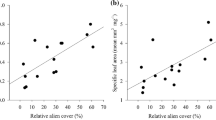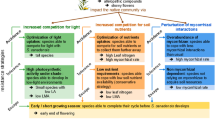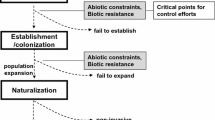Abstract
Invasion ecology has much advanced since its inception. Nevertheless, explanation, prediction, and management of biological invasions remain difficult. Management of alien species is often hindered by crypticity in biological invasions. The present study attempts to address the crypticity in ecological functions using insights from selected plant species, namely Lantana camara L. (sensu lato), an established invader and Ricinus communis L., a naturalized species in India. The study species have a broad habitat suitability range and continue to expand in India. We hypothetically placed the study species on the unified framework for biological invasions to assess the performance strategies (manifestations of changing or novel ecological functions) which facilitate a species to breach/overcome the environmental barrier (light availability) and expand in time and space. Results affirmed hypothetical placement of the two species on the unified framework. In view of the results, Lantana camara is expanding its range in shaded habitats and Ricinus communis, as of now, exhibits boom and bust cycles, but may pose a significant invasion risk in the near future through breach of an environmental barrier. The study enabled us to understand how plant performance-related traits and species’ trait modulation potential assist the species in breaching/overcoming barriers to colonize, invade and/or expand. The study generates an impetus for trait-based studies focusing on understudied cryptic functional changes of species.


Similar content being viewed by others
References
Blackburn TM, Pyšek P, Bacher S, Carlton JT, Duncan RP et al (2011) A proposed unified framework for biological invasions. Trends Ecol Evol 26:333–339
Colautti RI, MacIsaac HJ (2004) A neutral terminology to define ‘invasive’ species. Divers Distrib 10:135–141
Crees JJ, Turvey ST (2015) What constitutes a ‘native’ species? Insights from the quaternary faunal record. Biol Cons 186:143–148
Essl F, Bacher S, Genovesi P, Hulme PE, Jeschke JM et al (2018) Which taxa are alien? Criteria, applications, and uncertainties. Bioscience 68:496–509
Global Invasive Species Database (GISD) (2015) Version 2015.1. http://www.iucngisd.org/gisd/. Accessed 3 Jan 2019
Goncalves E, Herrera I, Duarte M, Bustamante RO, Lampo M et al (2014) Global invasion of Lantana camara: has the climatic niche been conserved across continents? PLoS One 9:e111468
Goyal N (2015) Focus of plant invasion research in India: interests and prospects. The Botanica 64–65:229–237
Goyal N (2018) Plant invasions in heterogeneous environments. Ph.D. Thesis. University of Delhi, Delhi, India
Goyal N, Sharma GP (2015) Lantana camara L. (sensu lato): an enigmatic complex. NeoBiota 25:15–26
Goyal N, Sharma GP (2016) Emerging invaders from the cultivated croplands: an invasion perspective. In: Rajpal VR, Rama Rao S, Raina SN (eds) Gene pool diversity and crop improvement. Springer International Publishing, Berlin, pp 271–290
Goyal N, Sharma GP (2019) It takes two to tango: variable architectural strategies boost invasive success of Lantana camara L. (sensu lato) in contrasting light environments. Biol Invasions 21:163–174
Goyal N, Pardha-Saradhi P, Sharma GP (2014) Can adaptive modulation of traits to urban environments facilitate Ricinus communis L. invasiveness? Environ Monit Assess 186:7941–7948
Goyal N, Esler KJ, Sharma GP (2018a) What drives performance potential of Lantana camara L. (sensu lato) in the invaded range? Trop Ecol 59:57–68
Goyal N, Shah K, Sharma GP (2018b) Does intrinsic light heterogeneity in Ricinus communis L. monospecific thickets drive species’ population dynamics? Environ Monit Assess 190:410
Heger T, Trepl L (2003) Predicting biological invasions. Biol Invasions 5:313–321
Henderson S, Dawson TP, Whittaker RJ (2006) Progress in invasive plants research. Prog Phys Geogr 30:25–46
Jarić I, Heger T, Monzon FC, Jeschke JM, Kowarik I et al (2019) Crypticity in biological invasions. Trends Ecol Evol 34:291–302
Khuroo AA, Reshi ZA, Malik AH, Weber E, Rashid I et al (2012) Alien flora of India: taxonomic composition, invasion status and biogeographic affiliations. Biol Invasions 14:99–113
Melbourne BA, Cornell HV, Davies KF, Dugaw CJ, Elmendorf S et al (2007) Invasion in a heterogeneous world: resistance, coexistence or hostile takeover? Ecol Lett 10:77–94
Pandey A, Sharma GP (2013) Plant invasion researches in India: how long do we have to wait for appropriate management options? Curr Sci 104:408–409
Pecl GT, Araújo MB, Bell JD, Blanchard J, Bonebrake TC et al (2017) Biodiversity redistribution under climate change: impacts on ecosystems and human well-being. Science 355:eaai9214
Prentis PJ, Pavasovic A (2013) Understanding the genetic basis of invasiveness. Mol Ecol 22:2366–2368
Prentis PJ, Wilson JRU, Dormontt EE, Richardson DM, Lowe AJ (2008) Adaptive evolution in invasive species. Trends Plant Sci 13:288–294
Pyšek P, Pergl J, Essl F, Lenzner B, Dawson W et al (2017) Naturalized alien flora of the world: species diversity, taxonomic and phylogenetic patterns, geographic distribution and global hotspots of plant invasion. Preslia 89:203–274
Ray A, Ray R (2014) Rapid divergence of ecotypes of an invasive plant. AoB Plants 6:plu052
Richardson DM, Pyšek P (2006) Plant invasions- merging the concepts of species invasiveness and community invasibility. Prog Phys Geogr 30:409–431
Richardson DM, Pyšek P, Rejmánek M, Barbour MG, Panetta FD et al (2000) Naturalization and invasion of alien plants: concepts and definitions. Divers Distrib 6:93–107
Schreiber SJ, Lloyd-Smith JO (2009) Invasion dynamics in spatially heterogeneous environments. Am Nat 174:490–505
Sharma GP, Singh H, Singh JS (2012) Ecology of plant invasions with particular reference to India. In: Sharma AK, Ray D, Ghosh SN (eds) Biological diversity: origin, evolution and conservation. Viva Books Private Limited, New Delhi, pp 77–107
Simberloff D, Martin JL, Genovesi P, Maris V, Wardle DA et al (2013) Impacts of biological invasions: what’s what and the way forward. Trends Ecol Evol 28:58–66
Sokol NW, Kuebbing SE, Bradford MA (2017) Impacts of an invasive plant are fundamentally altered by a co-occurring forest disturbance. Ecology 98:2133–2144
Williamson M (1996) Biological invasions. Chapman and Hall, London
Williamson M, Fitter A (1996) The varying success of invaders. Ecology 77:1661
Zenni RD, Nuñez MA (2013) The elephant in the room: the role of failed invasions in understanding invasion biology. Oikos 122:801–815
Zenni RD, Dickie IA, Wingfield MJ, Hirsch H, Crous CJ et al (2017) Evolutionary dynamics of tree invasions: complementing the unified framework for biological invasions. AoB Plants 9:5
Acknowledgements
This paper is the crux of the thesis work of NG. NG thanks University Grants Commission, India for Senior Research Fellowship. GPS acknowledges funding support from the University of Delhi, India and Science and Engineering Research Board, Department of Science and Technology, India. Insights gained during discussions with distinguished invasion ecologists at NeoBiota 2018, 10th International Conference on Biological Invasions: New Directions in Invasion Biology, Dun Laoghaire, Ireland improved ideation in the manuscript.
Author information
Authors and Affiliations
Corresponding author
Rights and permissions
About this article
Cite this article
Goyal, N., Sharma, G.P. Unveiling cryptic ecological functions: prospects in plant invasions. Trop Ecol 60, 1–5 (2019). https://doi.org/10.1007/s42965-019-00002-7
Published:
Issue Date:
DOI: https://doi.org/10.1007/s42965-019-00002-7




